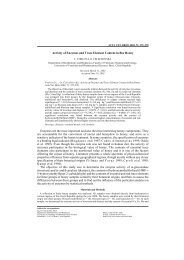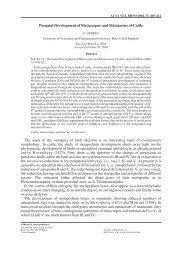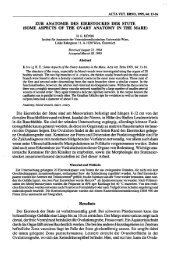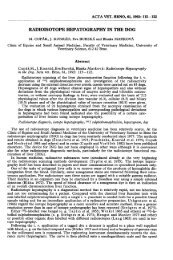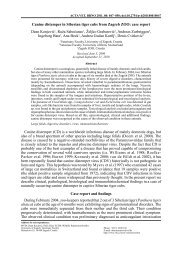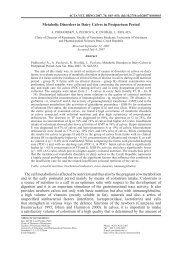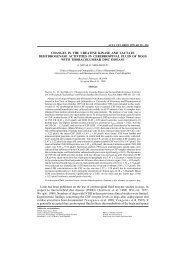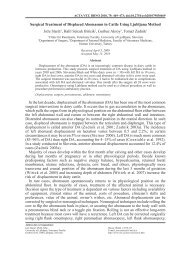Full text - Acta Veterinaria Brno
Full text - Acta Veterinaria Brno
Full text - Acta Veterinaria Brno
You also want an ePaper? Increase the reach of your titles
YUMPU automatically turns print PDFs into web optimized ePapers that Google loves.
204<br />
and hygienic rules are neit observed. In the present material. sometimes the<br />
endoparasite species of the mother did not agree with that of her own calf. but<br />
among the calv.es and other mothers in the same calving pen they did. From<br />
conforming findings of various farms it is ev.ident that large-scale buildings are<br />
contaminated with endoparasites already at the beginning of operation and that the<br />
source of infection are not only the true mothers. The present results showed that<br />
the transfer of coccidia into the alimentary tract of the animals cannot be prevented<br />
at the present time under operational conditions~ Clinical disorders are most<br />
frequently produced by a larger number of parasities that could be effectively<br />
limited when establishing "all in - all out" systems of housing.<br />
Measures aimed at control of endoparasite transfer are similar to those aimed<br />
at prevention of bacterial and viral contamination of premises. It is a must to observe<br />
the hygiene of udder. cleanness of the vessels from which· the calves drink. to keep<br />
the floor clean and to change the litter in the boxes of the calves very regularly.<br />
Faeces should be removed especially from the surfaces licked by the calves. •<br />
J e h I i f k a (1966) noticed a sucking reflex which lasted for 30 minutes after<br />
the calf drank mUIt. He reccomends tliat the calves be fixed for about half an hour<br />
after drinking milk until the sucking reflex disappears. Pol ik (1980) and other<br />
authors recommended the "all in - all out" system of housing f .... calf houses as well.<br />
Men II i k et aI. (1983) recommended calv.ing pens with this operation in isolated<br />
sections. They recommend that the calf house be divided into a larger number of<br />
separate sections. or at least into two parts. with alternating operation in order that<br />
the free part could be disinfected. and to house the calves intoindiv.idual box.es.<br />
K r e j f i et al. (1984) and other authors propose similar measures. The measures<br />
proposed are very convenient also for reducing the transfer of endoparasites in<br />
calving pens and calf houses. Coccidia oocysts and helminth eggs are very resistant<br />
to various disinfectants. That is why regular and tborcugh mechanical cleaning<br />
remov.ing most of the parasites is so important.<br />
H 0 j 0 v e c et al. (1973) drew attention to the fact that the preventive<br />
measures should be aimed. in the first place. at increasing the specific resistance<br />
of the calv.es even before transport into large-scale calf houses. Repeated examinations<br />
showed that the majority of mothers and nurse cows are virtually permanently<br />
parasitized with coccidia (frequently with several species). The nearly permanent<br />
presence of endoparasites in the organism enables to obtain and maintain antiparaaitary<br />
immunity of the mothers and to form conditions for colostral immunity of<br />
the calves. Small doses of parasites create conditions for the development of defence<br />
mechanisms ..·early as in the very young calves.<br />
In the present material from various calving pens and calf houses. coccidia of<br />
the genus EimeJlia were found in very low intensities. helminths only sporadically.<br />
It is improbable that the endoparasites mentioned would be of greater importance in<br />
diarrheal disorders of newborn calves. More important is the transfer of coccidia<br />
from calving pens and calf houses into large-scale calf houses.<br />
Inftlrodni teat endoparality v porodn4ch a profylaktorilch<br />
Telata jllOu infikovtna kokcidiemi a helminty jii pfi poroditim olletfovini. sini a<br />
olizovini. Zdrojem nikazy jsou matky a kojne krtvy. V dele poulivanych porodnich<br />
vylufovalo 97.7 , matek kokcidie. sUni! patogenni druhy EimeJlia zueJ/II.U 82.8'.<br />
E. bov.u 60.7 ,. helminty vylufovalo 41.3 , matek. V porodnich a profylaktoriich<br />
ulivanych vice let vylufovalo 42.2 , telat kokcidie: 26.9 9; E. zueJ/ll.U. 21.7 ,<br />
E. bov.u a 2.8 , helminty. Byla sledovina kontaminace novi! vybudovanych objektd<br />
pH uvidi!ni do provozu: Po zavedeni do otevirane porodny vylufovalo 88.4 , prvotelek<br />
kokcidie a 16.3 , helminty. V novem profylaktoriu vylufovalo 36.4 , telat<br />
kokcidie a 10.6 , helminty. Za 13 dnd po naskladni!ni do noveho velkokapacitnlho<br />
teletnlku bylo jil 72.8 , telat parazitovtno kokcidiemi a 17.3 9; helminty.<br />
Jil z poroden a profylaktoril se Iliff druhy endoparazitd (jsou uvedeny ve vysledclch).<br />
kterj'm ekologicky vyhovuje stijove prostfedi. SiIni! patogenni druhy<br />
kokcidii byly shodni! zjilltov.tny v.e vllech sledovanych objektech. Kokcidie pfentiieji<br />
zejmena slabi. starlli telata. kteri byvaji ponechtvtna dele v profylaktoriich. Pfi dodrlovtni<br />
technologicke a hygienicke kbni! turnusoveho zistavu je mnozstvi parazltirnich<br />
agens pfilill male k vyvolini klinickych pfiznakd. ale umolnuje rozvoj obran-



